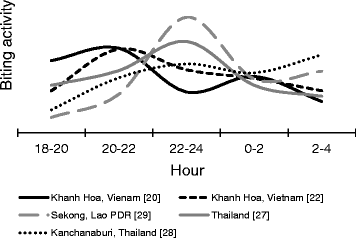Molecular epidemiology of mosquitoes for the transmission of forest malaria in south-central Vietnam
- PMID: 29046610
- PMCID: PMC5637239
- DOI: 10.1186/s41182-017-0065-6
Molecular epidemiology of mosquitoes for the transmission of forest malaria in south-central Vietnam
Abstract
Human infection caused by non-human primate malarial parasites, such as Plasmodium knowlesi and Plasmodium cynomolgi, occurs naturally in Southeast Asian countries, including Vietnam. Members of the Anopheles dirus species complex are known to be important vectors of human malarial parasites in the forested areas of southern and central Vietnam, including those in Khanh Phu commune and Khanh Hoa Province. Recent molecular epidemiological studies in Vietnam have reported cases of co-infection with Plasmodium falciparum, Plasmodium vivax, Plasmodium malariae, and P. knowlesi in An. dirus. The commonly found macaques in the forest in the forested areas are suspected to be bitten by the same An. dirus population that bites humans. A recent epidemiological study identified six species of malarial parasites in sporozoite-infected An. dirus using polymerase chain reaction, of which P. vivax was the most common, followed by P. knowlesi, Plasmodium inui, P. cynomolgi, Plasmodium coatneyi, and P. falciparum. Based on a gametocyte analysis, the same allelic gametocyte types were observed in both humans and mosquitoes at similar frequencies. These observations suggest that people who stay overnight in the forests are frequently infected with both human and non-human primate malarial parasites, leading to the emergence of novel zoonotic malaria. Moreover, it is suggested that mosquito vector populations should be controlled and monitored closely.
Keywords: Anopheles dirus; Gametocyte; Plasmodium coatneyi; Plasmodium cynomolgi; Plasmodium falciparum; Plasmodium inui; Plasmodium knowlesi; Plasmodium vivax; Sporozoites; Vietnam.
Conflict of interest statement
Ethics approval and consent to participate
This study was certified as permitted standard procedures by the National Institute of Malariology, Parasitology and Entomology in Hanoi, and was reviewed and approved by the ethics committees of Institute of Tropical Medicine, Nagasaki University (permit number: 10121662-5). All adult volunteers including mosquito collectors provided informed consent and for children, consent was obtained from close relatives.
Consent for publication
Not applicable.
Competing interests
The author declares no competing interests.
Publisher’s Note
Springer Nature remains neutral with regard to jurisdictional claims in published maps and institutional affiliations.
Figures
Similar articles
-
Prevalence of human and non-human primate Plasmodium parasites in anopheline mosquitoes: a cross-sectional epidemiological study in Southern Vietnam.Trop Med Health. 2019 Jan 23;47:9. doi: 10.1186/s41182-019-0139-8. eCollection 2019. Trop Med Health. 2019. PMID: 30692869 Free PMC article.
-
Humans frequently exposed to a range of non-human primate malaria parasite species through the bites of Anopheles dirus mosquitoes in South-central Vietnam.Parasit Vectors. 2015 Jul 16;8:376. doi: 10.1186/s13071-015-0995-y. Parasit Vectors. 2015. PMID: 26178324 Free PMC article.
-
Co-infections of Plasmodium knowlesi, P. falciparum, and P. vivax among Humans and Anopheles dirus Mosquitoes, Southern Vietnam.Emerg Infect Dis. 2011 Jul;17(7):1232-9. doi: 10.3201/eid1707.101551. Emerg Infect Dis. 2011. PMID: 21762577 Free PMC article.
-
Zoonotic malaria - global overview and research and policy needs.Front Public Health. 2014 Aug 18;2:123. doi: 10.3389/fpubh.2014.00123. eCollection 2014. Front Public Health. 2014. PMID: 25184118 Free PMC article. Review.
-
Zoonotic malaria transmission and land use change in Southeast Asia: what is known about the vectors.Malar J. 2022 Mar 31;21(1):109. doi: 10.1186/s12936-022-04129-2. Malar J. 2022. PMID: 35361218 Free PMC article. Review.
Cited by
-
Plasmodium cynomolgi Infections Not Found in Microscopy-Diagnosed Malaria Cases across Sabah, Malaysia.Am J Trop Med Hyg. 2024 Nov 12;112(1):85-88. doi: 10.4269/ajtmh.24-0264. Print 2025 Jan 8. Am J Trop Med Hyg. 2024. PMID: 39531730 Free PMC article.
-
Ape Origins of Human Malaria.Annu Rev Microbiol. 2020 Sep 8;74:39-63. doi: 10.1146/annurev-micro-020518-115628. Annu Rev Microbiol. 2020. PMID: 32905751 Free PMC article. Review.
-
Prevalence of human and non-human primate Plasmodium parasites in anopheline mosquitoes: a cross-sectional epidemiological study in Southern Vietnam.Trop Med Health. 2019 Jan 23;47:9. doi: 10.1186/s41182-019-0139-8. eCollection 2019. Trop Med Health. 2019. PMID: 30692869 Free PMC article.
-
Mosquitoes and Mosquito-Borne Diseases in Vietnam.Insects. 2022 Nov 22;13(12):1076. doi: 10.3390/insects13121076. Insects. 2022. PMID: 36554986 Free PMC article. Review.
-
Plasmodium genomics: an approach for learning about and ending human malaria.Parasitol Res. 2019 Jan;118(1):1-27. doi: 10.1007/s00436-018-6127-9. Epub 2018 Nov 6. Parasitol Res. 2019. PMID: 30402656 Review.
References
-
- WHO . World malaria report 2016. Geneva: World Health Organization; 2016.
-
- Grietens KP, Xuan XN, Ribera J, Duc TN, Bortel WV, Ba NT, Van KP, Xuan HL, D'Alessandro U, Erhart A. Social determinants of long lasting insecticidal hammock use among the Ra-glai ethnic minority in Vietnam: implications for forest malaria control. PLoS One. 2012;7(1):e29991. doi: 10.1371/journal.pone.0029991. - DOI - PMC - PubMed
-
- Collins WE. Major animal models in malaria research: simian. In: Wernsdofer WH and McGregor S ediors. Malaria: principles and practice of Malariology. Edinburgh: Churchill Livingstone; 1988. P. 1473-1501.
Publication types
LinkOut - more resources
Full Text Sources
Other Literature Sources

